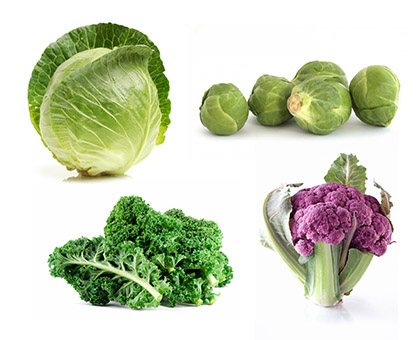Cabbage Patch
If there’s any group of vegetables deserving of praise, it’s the cruciferous family, which includes Brussels sprouts, cabbage, cauliflower, Swiss chard, kale and more. Full of vitamins A and C and rich in antioxidants, cruciferous veggies pack a serious nutritional punch and fight against many cancers. All of these vegetables bear four-petal flowers and shine this time of year. Use our suggestions as inspiration to incorporate these tasty and versatile vegetables into your everyday meals.
Kale: Kale is a nutrient-rich powerhouse that’s an excellent source of beta-carotene and vitamins A, C and K. It has mild, earthy flavors that are sweeter in varieties with smaller leaves. Toss kale into salads, hot pasta dishes or stir-fries, incorporate it into smoothies, or roast it to create deliciously addicting kale chips.
Swiss Chard: Known for being one of the most nutritious vegetables in the world, Swiss chard aids in weight loss, reduces inflammation, promotes healthy bones and much more. Enjoy Swiss chard on its own by sautéing it in a bit of olive oil or add it to soups, salads, stir-fries or omelets.
Cabbage: From the red and green varieties to their sweeter relatives, napa and savoy, cabbage makes a great addition to slaws, salads, soups and stir-fries. Choosing the right cooking technique preserves its sweetness: sauté cabbage just to the point when its color is brightest to keep its natural sugars. Look for heavy heads with tightly bound leaves; they’re best eaten within five days, but can keep in the refrigerator for longer periods of time.
Brussels Sprouts: For those of us who love the piquancy of bitter flavors, Brussels sprouts are a tremendous pleasure. Roasted or sautéed, paired with bacon or butter, these tiny cabbage-like vegetables – probably developed in 15th-century Belgium – add a sophisticated note to the menu. If you decide to sauté, blanch first and then introduce them to the skillet; blanching produces a milder flavor.
Cauliflower: Loaded with vitamin C, cauliflower has become a highlight on plates in various forms. Turn cauliflower into rice and use it as the base for crusts, veggie burgers and risottos; mash it and enjoy as a lower-carb stand-in for mashed potatoes or serve it like a steak veggie-style. It’s available in a variety of hues, including white, green, purple and orange. Wrapped tightly in plastic wrap, cauliflower will keep refrigerated up to one week.








